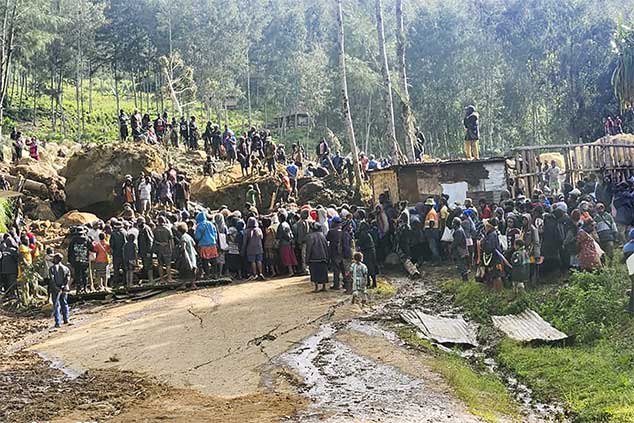At least 2,000 feared dead in Papua New Guinea landslide. These are some challenges rescuers face

World
At least 2,000 feared dead in Papua New Guinea landslide. These are some challenges rescuers face
BANGKOK (AP) — The Papua New Guinea government said more than 2,000 people are believed to have been buried alive in a landslide in the South Pacific island nation, after the side of a mountain came down in the early hours of Friday morning when the village of Yambali was asleep.
The settlement is located in a restive and remote area in the interior of the poor, rural nation off the northern coast of Australia, making search and rescue efforts complicated and hazardous.
The government death toll is roughly triple the U.N. estimate of 670 killed. The remains of only six people had been recovered so far.
In a letter seen by The Associated Press to the United Nations resident coordinator dated Sunday, the acting director of Papua New Guinea’s National Disaster Center Luseta Laso Mana said the landslide “buried more than 2,000 people alive” and caused “major destruction” at Yambali village in the Enga province.
Estimates of the casualties have varied widely since the disaster occurred, and it was not immediately clear how officials arrived the number of people affected.
Here’s a look at some of the challenges:
DIFFICULT ACCESS, RESTIVE POPULATION
The village of at least 4,000, but believed to be substantially larger, is in a mountainous and forested part of Papua New Guinea’s Enga province. It’s located alongside a winding highway to the town of Porgera and a mine that has produced billions of dollars of gold but whose security personnel have been accused by rights groups of abuses.
The highway was covered by the landslide, effectively cutting off Porgera and the other villages past Yambali from the provincial capital of Wabag, some 60 kilometers (35 miles) from where the disaster occurred.
Emergency responders have brought aid in from Wabag, but have had to make the final 200 meters (yards) of the journey by foot over the rubble-covered highway.
Debris 6 to 8 meters (20 to 26 feet) deep covering an area the size of three or four football fields was being cleared exclusively by hand with shovels and picks for more than two days, until an excavator donated by a local builder arrived on Sunday.
Survivors have been hesitant to allow heavy machinery to be used, however, because they do not want the bodies of their relatives harmed, said Serhan Aktoprak, the chief of the U.N. migration agency’s mission in Papua New Guinea. The donated excavator was driven away Monday morning, though it’s not clear whether that was related to locals’ objections or for another reason, he said.
Military engineers with additional heavy equipment are being transported to the disaster scene 400 kilometers (250 miles) from the east coast city of Lae and are expected to arrive Tuesday or Wednesday.
DEADLY LOCAL FEUDS ARE COMPLICATING THE RESPONSE
Longtime tribal warfare in Enga province has not relented despite the disaster, meaning that soldiers have had to provide security for the aid convoys heading toward Yambali.
At least 26 men were killed in an ambush in February, and eight more died in a clash between two rival clans on Saturday in a longstanding dispute that’s unrelated to the landslide. About 30 homes and five retail businesses were burned down in the fighting, officials said.
Convoys have only been able to travel by daylight due to the security risks, and with a two-hour drive each way, their time on site has been seriously restricted, Aktoprak said in a phone interview from Port Moresby, the country’s capital.
Approximately 25 people from the U.N., other agencies and the military have been making the daily journey. On Monday, they reported seeing burning houses and men armed with machetes along the way, Aktoprak said.
Emergency crews also face the threat of an ongoing natural disaster as the earth continues to shift in the disaster zone.
The debris is getting increasingly waterlogged from three streams covered by the landslide, making it dangerous to work on and increasing the possibility it could slide farther downhill. Communities below have already been evacuated, Aktoprak said.
“We have a situation that is getting worse and worse every moment,” he said.


